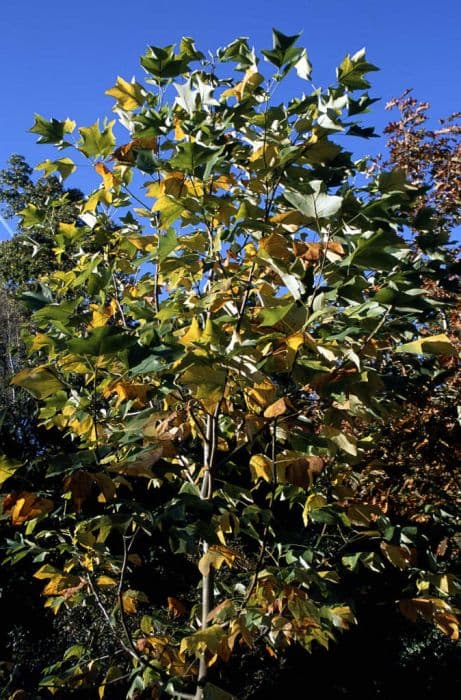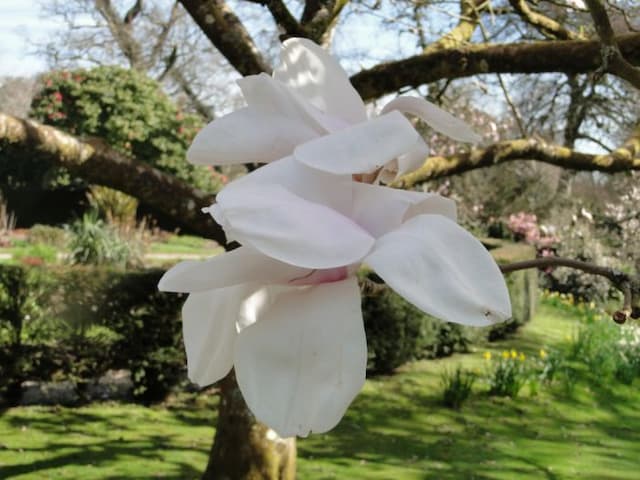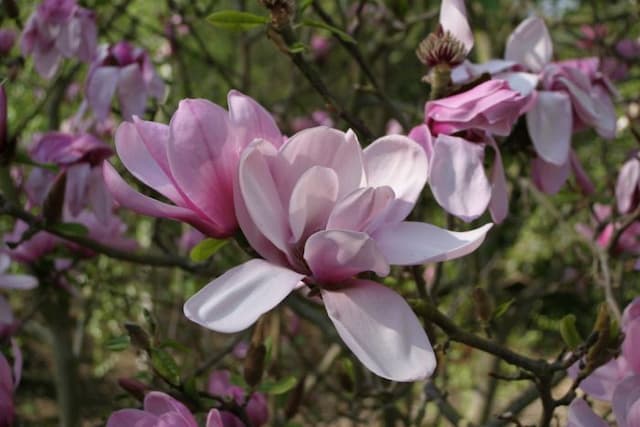Star Magnolia Magnolia 'George Henry Kern'

ABOUT
Magnolia 'George Henry Kern' is a garden plant that is admired for its showy flowers and attractive form. The flowers are a standout feature, which bloom in a gorgeous pale pink hue, with a slight purple tinge at the base that radiates out to a softer pink at the tips. These flowers tend to be tulip-shaped when they start to open, with multiple tepals that peel back to reveal the interior of the bloom. The foliage of Magnolia 'George Henry Kern' is also visually appealing, with leaves displaying a glossy green color that provides a lush backdrop for the blossoms. During the blooming season, the contrast between the tender pink flowers and the vibrant green leaves creates a delightful display in the landscape. The overall habit of the plant is gracefully structured with many branching stems that give it a thoughtful, yet natural appearance. It provides a visual anchor in gardens and outdoor spaces, often bursting into its floral display when many other plants are just beginning to emerge in early spring. Though I cannot describe the exact size, the plant's visual impact in a garden is proportional to its dimensions, fitting well into mixed borders and often serving as an ornamental specimen due to its beautiful flowers and foliage.
About this plant
 Names
NamesFamily
Magnoliaceae
Synonyms
George Henry Kern Magnolia
Common names
Magnolia × loebneri 'George Henry Kern'.
 Toxicity
ToxicityTo humans
The Magnolia 'George Henry Kern', commonly referred to as a Magnolia, is not widely regarded as toxic to humans. However, as with many plants, certain individuals may have sensitivities or allergic reactions if they ingest or come into contact with parts of the plant. If a person ingests part of a Magnolia, it is generally not considered poisonous, but it is advised to seek medical attention if any adverse symptoms occur, as individual reactions can vary.
To pets
Magnolia 'George Henry Kern', commonly known as Magnolia, is not typically toxic to pets. It's considered to be of low toxicity risk for cats and dogs. There might be mild gastrointestinal upset if pets ingest parts of the plant, like vomiting or diarrhea, which usually resolves without serious consequence. However, it is always prudent to discourage pets from eating plants and monitor them for any signs of distress after ingestion. If concerning symptoms appear, contact a veterinarian.
 Characteristics
CharacteristicsLife cycle
Perennials
Foliage type
Deciduous
Color of leaves
Green
Flower color
Pink
Height
10 feet (3 meters)
Spread
6 feet (1.8 meters)
Plant type
Shrub
Hardiness zones
5
Native area
Hybrid
Benefits
 General Benefits
General Benefits- Aesthetic Appeal - Magnolia 'George Henry Kern' is valued for its large, showy flowers that add beauty to any landscape.
- Spring Blooms - It blossoms with pink and purple flowers in early spring, providing an early splash of color.
- Attracts Wildlife - Its flowers attract pollinators like bees, butterflies, and birds, which are essential for the health of the ecosystem.
- Shade Provider - As a tree, it can provide shade, which can be beneficial in creating comfortable outdoor living spaces and reducing cooling costs in nearby buildings.
- Year-Round Interest - With its evergreen or semi-evergreen foliage, depending on the climate, it offers visual interest throughout the year.
- Low Maintenance - Once established, it requires relatively low maintenance, making it suitable for both novice and experienced gardeners.
 Medical Properties
Medical Properties- This plant is not used for medical purposes.
 Air-purifying Qualities
Air-purifying QualitiesThis plant is not specifically known for air purifying qualities.
 Other Uses
Other Uses- Photography Subject: The Magnolia 'George Henry Kern' is often used as a subject for photographers, especially in spring when its beautiful flowers are in full bloom.
- Artistic Inspiration: The unique appearance of its flowers provides inspiration for artists and can be seen in various forms of artwork such as paintings and sculptures.
- Wedding Decor: Its flowers and branches are sometimes used in wedding bouquets and as decorative elements in ceremonies for their natural beauty and elegance.
- Culinary Garnish: Although not commonly known for edibility, the petals can be used as a delicate garnish on special dishes in high-end culinary presentations.
- Crafting: The sturdy leaves and dried flowers of Magnolia 'George Henry Kern' can be used in crafting, such as in wreath-making or as part of dried flower arrangements.
- Educational Tool: Used in botany and horticulture classes as a live example to study the characteristics of the Magnoliaceae family.
- Nature-Inspired Perfumery: Some perfumers may use the fragrance of Magnolia 'George Henry Kern' flowers as inspiration for creating botanical essences in perfumes.
- Feng Shui: In the practice of Feng Shui, a Magnolia tree in the garden is sometimes considered to bring peace and harmony to the household.
- Dye Production: The bark or seed pods can be used to create botanical dyes for textiles, although this is not a common practice.
- Relaxation Spaces: Due to its calming presence, the Magnolia 'George Henry Kern' is often planted in spaces designed for meditation and relaxation.
Interesting Facts
 Feng Shui
Feng ShuiThe Magnolia is associated with purity and nobility and can be used in Feng Shui to bring peaceful energy and an element of freshness to a space. It is often placed in the front yard or near the entrance to invite positive energy into the home.
 Zodiac Sign Compitability
Zodiac Sign CompitabilityThe Magnolia is not used in astrology practice.
 Plant Symbolism
Plant Symbolism- Perseverance: Magnolias are known for their ability to withstand harsh conditions, as 'George Henry Kern' magnolia blooms early in the spring, often pushing through cold snaps.
- Nobility: With its large, showy flowers, the magnolia is often associated with dignity and a regal bearing, symbolizing an individual's noble spirit.
- Feminine beauty: The magnolia's delicate and fragrant blooms are commonly linked to the softness, purity, and beauty in women.
- Inner strength: The hardy nature of the 'George Henry Kern' magnolia, along with its sturdy wood, represents inner strength and resilience.
- Welcome: In the South, magnolias are often planted near the home as a sign of hospitality and to welcome guests, embodying a warm and friendly spirit.
 Water
WaterThe Magnolia 'George Henry Kern', commonly referred to as Star Magnolia, should be watered with care to avoid over-watering. It's advisable to water the plant thoroughly once a week with approximately 1.5 gallons of water, ensuring the soil is moist but not soggy. During the summer or dry spells, increase watering frequency to twice a week, while in the cooler months, reduce watering as the plant requires less moisture. Ensure the water is distributed evenly around the root zone of the tree. It's important to adjust the flow of water and frequency according to the specific microclimate and soil conditions of your garden.
 Light
LightStar Magnolia thrives in full sun to partial shade. The best spot for this plant would provide it with morning sunlight and afternoon shade, especially in regions with hot summers. Avoid placing it in deep shade, as it may hinder blooming and compromise the plant's vitality. Optimal performance is achieved with at least four hours of direct, unfiltered sunlight each day.
 Temperature
TemperatureStar Magnolia fares well in a range of moderate temperatures and is hardy to USDA zone 4. It can withstand minimum temperatures down to about -20 degrees Fahrenheit, while the maximum temperature it generally tolerates is 90 degrees Fahrenheit. The ideal temperature range for the Star Magnolia is between 60 and 72 degrees Fahrenheit.
 Pruning
PruningPrune Star Magnolia to maintain its shape and remove any dead or damaged branches. The best time to prune is soon after the tree has finished blooming in spring to minimize the loss of next year's flowers. Light pruning every year or two is sufficient to keep the plant healthy and well-shaped, focusing on any crossed or rubbing branches for optimal air circulation and structure.
 Cleaning
CleaningAs needed
 Soil
SoilStar Magnolias require well-draining, rich soil with compost mix. They prefer slightly acidic to neutral pH, between 5.5 and 7.0.
 Repotting
RepottingStar Magnolias, being slow-growing, need repotting every 2 to 3 years typically when roots fill the pot.
 Humidity & Misting
Humidity & MistingStar Magnolias thrive best in moderate humidity levels. They can adapt to average household humidity.
 Suitable locations
Suitable locationsIndoor
Use a bright spot, avoid dry heat, keep the soil moist.
Outdoor
Plant in well-drained soil, full sun to part shade.
Hardiness zone
5-9 USDA
 Life cycle
Life cycleThe Magnolia 'George Henry Kern', commonly known as George Henry Kern magnolia, begins its life as a seed, usually dispersed by the wind or wildlife. Once the seed finds suitable soil, it germinates and sprouts into a seedling, with the first leaves emerging to start photosynthesis. As it grows into a young sapling, it develops a sturdy root system and woody stem, eventually forming a recognizable magnolia shape with thick, glossy leaves. After several years, it reaches maturity and begins its flowering stage, producing fragrant, showy flowers that are pinkish-purple outside and white inside, typically in early spring before the foliage fully develops. Following pollination, which is often aided by bees and other insects, the flowers give way to cone-like fruit that releases seeds to continue the cycle. Throughout its life, the George Henry Kern magnolia will undergo periods of growth and dormancy, adapting to seasonal changes, and can live for many decades if in ideal conditions.
 Propogation
PropogationPropogation time
Spring-Early Summer
The most popular method of propagation for the Magnolia 'George Henry Kern,' commonly known as the saucer magnolia, is via semi-hardwood cuttings. This process is typically done during the late summer months. Cut a section of semi-hardwood about 4 to 6 inches (10 to 15 cm) in length that contains at least two sets of leaves. Remove the leaves from the lower half of the cutting and dip the cut end into a rooting hormone powder to enhance the chance of successful rooting. The cutting should then be placed in a pot filled with a mix of peat and perlite, ensuring that the lower nodes are buried. The pot needs to be kept in a warm environment with high humidity and indirect light until roots develop, which can take several weeks. Regularly check the moisture level in the soil and water when necessary to maintain slight dampness.









![Magnolia [Felix Jury]](/_next/image?url=https%3A%2F%2Fplants-admin.emdemapps.com%2Fimages%2Fplants%2F%2Fimages%2F604b61a0b23b7.png&w=640&q=75)